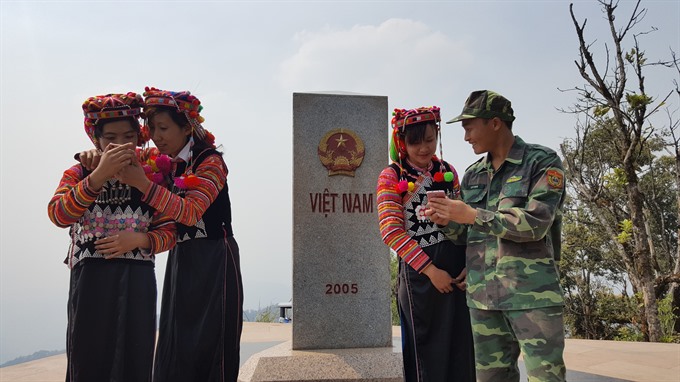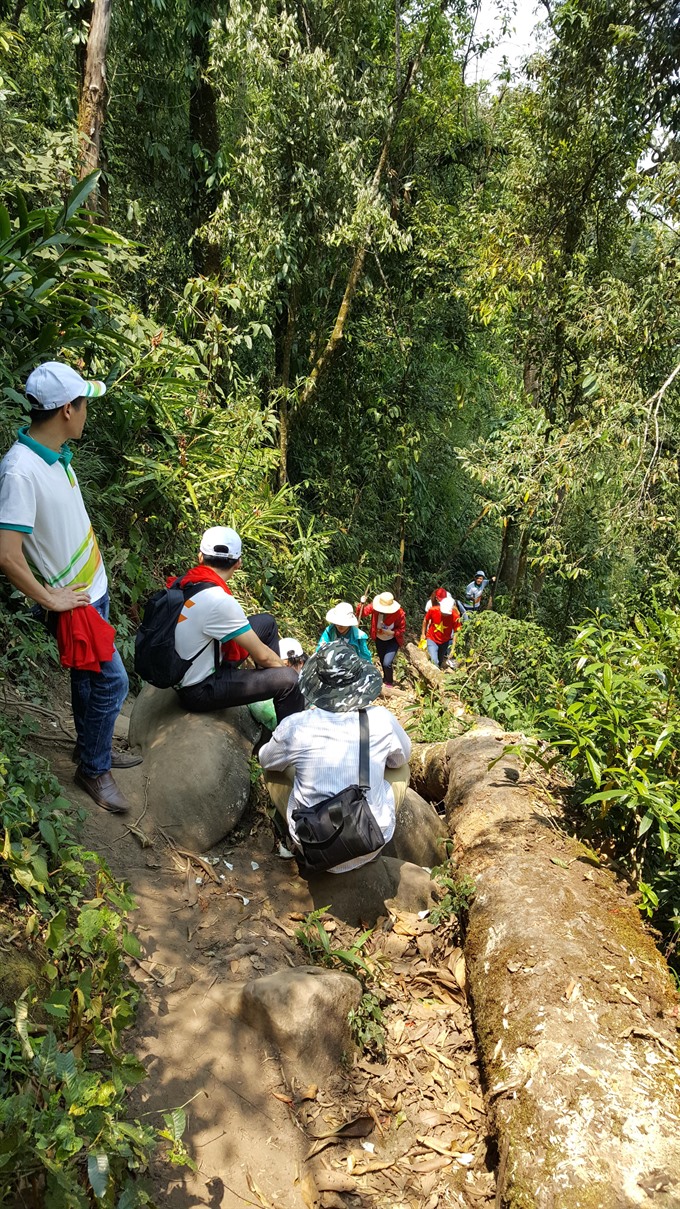 Economy
Economy

" />At a frontier area conterminous with Laos and China, the lives of locals and border guards get connected to a new high.
 |
| The lives of frontier residents and border guard soldiers have changed significantly since Viettel began providing mobile phone services, especially 4G. -- VNS Photo Hoàng Nam |
At a frontier area conterminous with Laos and China, the lives of locals and border guards get connected to a new high.
By Phạm Hoàng Nam
Vừ A Chua walks a lot.
His job requires him to.
A native of Điện Biên Province, the Mông man joined the border force a year ago, and is now a member of the Apachải Border Guard Post in Mường Nhé District, which straddles two borders, that with Laos and China.
“My work is to manage Vietnamese border line with Laos, which is seven days of walking through forests and mountains, and the Vietnamese border line with China, which is one day’s walking,” Vừ A Chua told Việt Nam News.
The post is 300km away from Điện Biên City and 800 km from Hà Nội.
While the job is difficult, there has been a qualitative change over the last five years, with the soldiers manning the frontier area carrying one more piece of equipment – mobile phones.
While this may not seem like a big deal in other areas, at the Apachải border it makes a huge difference.
After the military-run telecom firm, Viettel, brought the mobile phone service to the frontier area, Chua’s belongings have included a smart phone courtesy the 3G service, but he believes things will get even better.
“Viettel will provide the 4G service very soon, and my smart phone will help me remain close to my family,” Chua said.
Chua talks with his parents, who live in another district of Điện Biên, every day and his mobile phone is obviously very useful for him and his team.
“I can keep contact with my commanders, report any unusual situation and call for back-up if it is needed without any loss of time,” the young soldier said.
Chua was very enthusiastic as he took a group of reporters to his place of work, the national border milestone number 0, which is conterminous with Laos and China at the height of 1,800m above sea level. The trip’s aim was to witness the official launch of Viettel’s 4G service.
From the Apachải Border Guard Post, a car took the reporters through rough roads, still being built for nearly 8 km. Then, it stopped, and Chua led us to the national border marker number 0, on the “straight path,” with a friendly warning.
“We border guard soldiers take an hour and a half to get to the milestone, but you will take double that. Don’t carry anything else other than a water bottle. Soon, you will not want to carry anything.”
The straight path through the old forest was not easy. The group had to stop and take a break every 10-15 minutes, replenishment was needed in food and water far more often that we’d thought at the outset.
“We have to really admire the work that has been done to provide mobile service to a frontier area. I can’t image how the company was able to bring equipment to such a remote area and get them up a high mountain to build base transceiver station. How are they able to maintain it, when all we are doing is just walking and we are so tired?” wondered Lê Tuấn, a reporter with the People’s Police newspaper.
He had a point. We had, as Chua said, taken three hours to walk 7km to get to the border marker.
Điện Biên Province has 259 of the 36,000 4G base transceiver stations around the country, we learnt.
“To build one base transceiver station, we must carry 80 tonnes of equipment to the top of a mountain. This is mostly done by men, and this takes about VNĐ800 million (US$38,000) for transport only,” said Hoàng Mạnh Hưng, deputy director of Viettel branch in Điện Biên Province.
“And we transport around 3,000 litres of petrol for each base transceiver station in preparation for the rainy season, during which nothing can be transported,” Hưng added.
All technical preparations for launching the 4G service in Điện Biên province had been completed and it was to be tested at national border marker number 0, which is the westernmost point. The northernmost point is the Lũng Cú flagpole in the northern province of Hà Giang, the southernmost point is Ca Mau Cape in the province of the same name, and the easternmost point is Đôi Cape in the central province of Khánh Hòa.
Chua was visibly excited as he tested the 4G service by livestreaming when calling his parents: “Can you see the national border marker number 0? This is Việt Nam, this is Laos, and this is China. I go up here every week and today I’m very proud to show you the milestone.”
“From now on, I can show my commander where we have patrolled along our frontier,” he added.
Significant change
“The lives of frontier residents and border guard soldiers have significantly changed since Viettel began providing the mobile phone service here,” said Nguyễn Văn Công, another officer at the Apachải Border Guard Post.
Working in Apachải since 2011, Công recalled that at that time, his mobile phone worked only in high places, and this changed a year later.
“Viettel has made a very important step as they set up a system of base transceiver stations along Vietnamese border, this can help us a lot in our mission to protect and manage our border areas,” Công said.
“Right now, I can use facetime to see my little daughter every day through Viettel 4G service, that is amazing,” he added.
Echoing Công, Colonel Vũ Đình Bính, deputy head of the Apachải Border Guard Post, said: “Viettel has helped us send updates on the border situation, contact local residents, encourage the spirit of soldiers who live far away with their families and improve the living standards of local residents.”
The most telling comment of the day came from Vàng Seo Mẩy, an ethnic minority resident of the area: “With smartphones and 4G service of Viettel, ethnic minorities like us can connect with the world, expand our knowledge, learn how to improve our living standards and we feel the other parts of Việt Nam and the world is so close to us.” – VNS
 |
| The ‘straight path’ to go up to the national border marker number 0, where Việt Nam, Laos and China come together. -- VNS Photo Hoàng Nam |